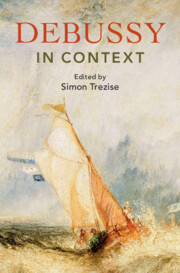Book contents
- Debussy in Context
- Composers in Context
- Debussy in Context
- Copyright page
- Dedication
- Contents
- Illustrations
- Contributors
- Preface
- Notes on the Text
- Abbreviations
- Part I Paris: City, Politics, and Society
- Part II The Arts
- Part III People and Milieu
- Chapter 12 Debussy and the Family in Third-Republic France
- Chapter 13 Romantic Relationships
- Chapter 14 Relationships with Poets and Other Literary Figures
- Chapter 15 Publishers
- Chapter 16 Composers with Whom Debussy Was Associated
- Chapter 17 Music Education and the Prix de Rome
- Part IV Musical Life: Infrastructure and Earning a Living
- Part V The Music of Debussy’s Time
- Part VI Performers, Reception, and Posterity
- Recommendations for Further Reading and Research
- Index
Chapter 13 - Romantic Relationships
from Part III - People and Milieu
Published online by Cambridge University Press: 23 May 2024
- Debussy in Context
- Composers in Context
- Debussy in Context
- Copyright page
- Dedication
- Contents
- Illustrations
- Contributors
- Preface
- Notes on the Text
- Abbreviations
- Part I Paris: City, Politics, and Society
- Part II The Arts
- Part III People and Milieu
- Chapter 12 Debussy and the Family in Third-Republic France
- Chapter 13 Romantic Relationships
- Chapter 14 Relationships with Poets and Other Literary Figures
- Chapter 15 Publishers
- Chapter 16 Composers with Whom Debussy Was Associated
- Chapter 17 Music Education and the Prix de Rome
- Part IV Musical Life: Infrastructure and Earning a Living
- Part V The Music of Debussy’s Time
- Part VI Performers, Reception, and Posterity
- Recommendations for Further Reading and Research
- Index
Summary
Debussy’s romantic relationships are considered in the context of the realities of class and social mobility in fin de siècle Paris. In terms of social origin, Debussy hailed from the working class. His parents briefly entered the ranks of the petite bourgeoisie when they owned a small pottery shop in Saint-Germain-en-Laye (1861–4). After selling the business, they moved to Paris and thereafter their various employments (and unemployment) placed them in the working class. In terms of social position, Debussy’s status was more nebulous. Money mattered, as did the way it was earned, but this income had to be complemented by a certain refinement, as well as a conformity to social manners and conventions. Such considerations presented possibilities for social ascension for the composer. On the one hand, his conservatoire training, Prix de Rome prize, and prodigious talent meant that he possessed the requisite degree of cultivation that made him welcome in bourgeois drawing rooms. On the other hand, the art of being ‘correct’ often eluded him, especially in his relationships with women. This chapter considers Debussy’s romantic relationships from the perspective of bourgeois marriage conventions and class mobility. Through matrimony, Debussy attempted on several occasions to marry upwardly, ultimately succeeding in 1908 with his marriage to Emma Bardac.
- Type
- Chapter
- Information
- Debussy in Context , pp. 126 - 134Publisher: Cambridge University PressPrint publication year: 2024

